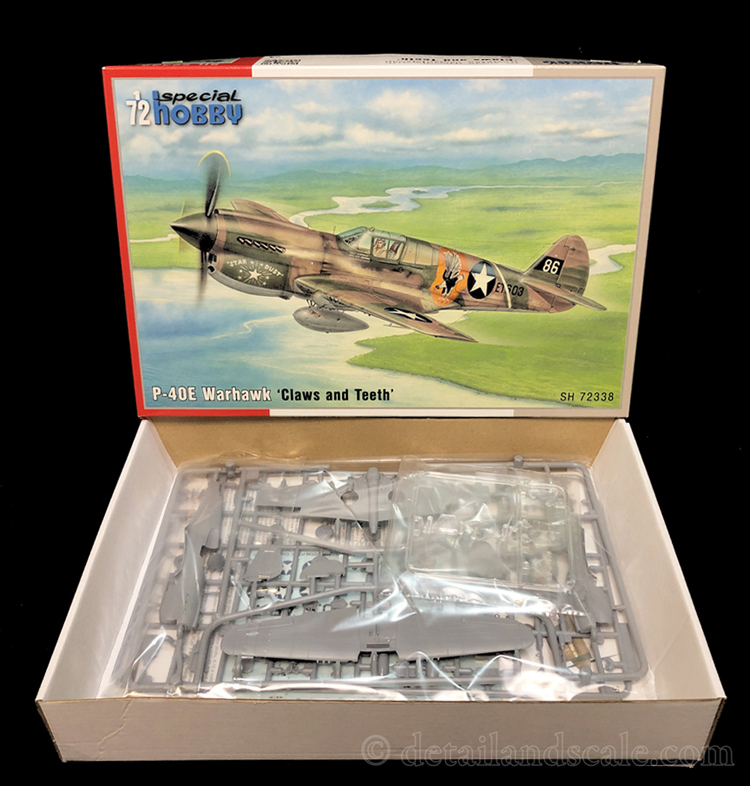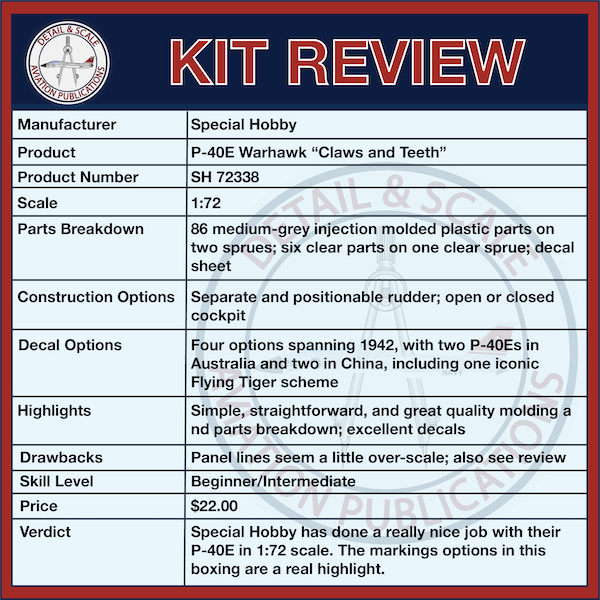Special Hobby P-40E Warhawk “Claws and Teeth”
1:72 Scale
1:72 Scale


The Curtiss P-40 Warhawk was one of the great fighter designs of the late 1930s. It was one of the most prolific designs of WWII and was one of the most widely employed aircraft of the conflict, seeing action in every theater. There have been a lot of kits of the P-40 in all the major scales. Special Hobby has been producing some great 1:72 scale P-40s lately, and here, we take a look at their recent release of a P-40E.

The Curtiss P-40 was designed to meet the requirements of a pursuit aircraft for the U. S. Army Air Corps in the mid-1930s. It was an evolution of the Curtis P-36 and, among other new features, did away with a radial engine and replaced it with a liquid-cooled, supercharged Allison V-1710 V-12 powerplant. The prototype XP-40 first flew in October 1938 out of the Curtiss facility in Buffalo, New York. The airplane was designed to be relatively inexpensive, adaptable to harsh operating conditions, able to soak up significant battle damage, and easy to repair. It also had to be highly agile at low and medium altitudes. In that part of the envelope, a P-40 could out-turn almost any opponent, but its single-stage supercharger meant that the P-40 would always be a plagued by poor performance at higher altitudes.
P-40s first saw combat with the British squadrons of the Desert Air Force in the Middle East and North African campaigns in mid-1941. It was with the RAF that the shark-mouth logo, rather inseparable from the identity of the P-40, was first applied. Between 1941 and 1944, the P-40 played key roles with Allied air forces in North Africa, the Pacific, and China along with other noted contributions in Eastern Europe, Italy, and Alaska. None may have been more famous than the Flying Tigers, the American Volunteer Group operating the P-40B in the early years of the war as a volunteer unit within the Chinese Air Force. The Warhawk performed quite well as an air superiority fighter, bomber escort, and fighter-bomber. Some 200 Allied fighter pilots achieved the status as an ace in the airplane. Production ceased by late November 1944 with the P-40 being produced in greater numbers than any U. S. WWII fighter with the exception of the the P-51 and P-47.
The P-40E was a derivation of the P-40D and had slightly more powerful engine and an additional .50-caliber machine gun in each wing, bringing the total to six. Some aircraft also had small underwing bomb shackles. The P-40E experienced the most air-to-air combat up to 1942 with the AVG in China and with the Royal Australian and New Zealand forces. Among Commonwealth nations, it was named the Kittyhawk IA.

Special Hobby’s 1:72 P-40E Warhawk “Claws and Teeth” kit consists of 86 injection molded medium grey polystyrene parts on two sprues and seven clear parts on one sprue. The full color instruction booklet guides assembly over 12 steps. Decals provide markings for four P-40Es:
- P-40E Warhawk 41-35954, ET600, 1st Lt. Andy Reynolds, 9th FS, 49th FG, Darwin, Australia, Summer 1942
- P-40E Warhawk 41-24872, Capt. R. Vaught, 9th FS, 49th FG, Livingstone Field, Darwin, Australia, May 1942
- P-40E Warhawk 41-36402, Lt. Dallas Clinger 16th FS, 23rd FG, Kwelien, China, September 1942
- P-40E Warhawk 106, ex-AVG pilot John Petach, 75th FS, 23rd FG, Hengyang, China, July 1942
Strengths: The Special Hobby P-40E is a very promising kit. As with their other 1:72 scale P-40s, it reflects the increasing quality of Special Hobby kits over the last several years. I think it indeed might be one of the nicest of their 1:72 scale kits to date.
Parts breakdown and engineering are both simple and straightforward. The exterior of the kit is very nicely molded revealing very smooth and flawlessly produced surfaces, panel lines, and a sparing number of rivet/fastener details. The cockpit it very nicely done, with separately molded sidewalls, a nice instrument panel and a decent seat. The left and right wings are molded as a continuous part (for both upper and lower wing halves) so that getting an equal dihedral won’t be a problem. Also, the rudder is a separate part and it can be positioned as the builder wishes. The clear parts are also really very nicely done. They are not too thick for 1:72 scale and they are crystal-clear with pristinely smooth surfaces.
The injection-molded parts for the carburetor intake screen faces are almost as nice as a photoetched metal part. There are alternative parts for closed and opened cowl flaps. The main gear well walls each come as a separate four-sided part that drops into the space between the wing halves, and just like that, you’ve got a very nice and complete gear well. Detail on the landing gear and wheels look quite nice, and the kit also includes a pair of bombs and two styles of underwing drop tanks. I also like how the complete gun barrels are molded over to the bottom of the upper wing half. This makes the fit with the bottom wing half and any necessary cleanup a lot easier and virtually trouble-free.
The paint scheme options are really well-chosen, and include some great shark mouth schemes, and of course, a Flying Tiger, too. The wicked vulture fuselage art on “Star Dust/Oklahoma Kid” is pretty cool, too. The decals themselves look awesome. They were printed by Cartograf and appear flawless in every respect.
Weaknesses: There’s not a lot that I can critique regarding this kit. I see no obvious flaws in shape, detail, or other elements. The only observation I might have is that for some scale modelers, the panel lines on the fuselage and wings might be a little overscaled – a little too wide and a little too deep. Personally, I think that once a few coats of paint are on and a panel line wash or a pencil treatment is applied, they should look a little less pronounced. And while not a critique per se and more reflective of my own preferences, I have never cared for decal seatbelts, and I do love separate control surfaces (here, elevators, ailerons, and landing flaps are not positionable).

Special Hobby has done a really nice job with their P-40E in 1:72 scale, and it has a lot to recommend to it, from the very impressive level of detail to the markings options. Special Hobby’s sister company CMK has released, timed with the arrival of this kit, a slew of resin detail sets, from cockpit parts (new sidewalls, control column), four different wheel sets with differing tread patterns, four different styles of pilot’s seat, and… wait for it… separate control surfaces for scale modelers like me. Overall, the level of detail that can be put into this kit at the end of the day is quite impressive – but even without any aftermarket enhancements, you can count on this kit as being able to build into a very nice model of the renowned Warhawk.
Sincere thanks are owed to Special Hobby for the review sample. You visit them on the web at http://www.specialhobby.info and on Facebook at https://www.facebook.com/specialhobby.
Haagen Klaus
Scale Modeling News & Reviews Editor
Detail & Scale


